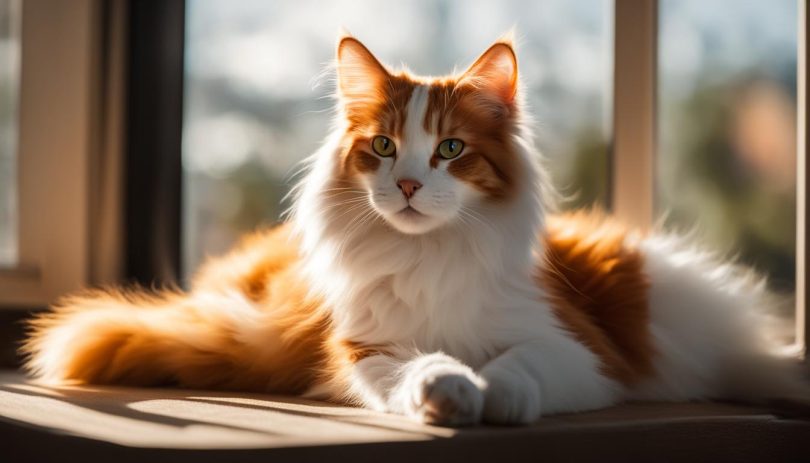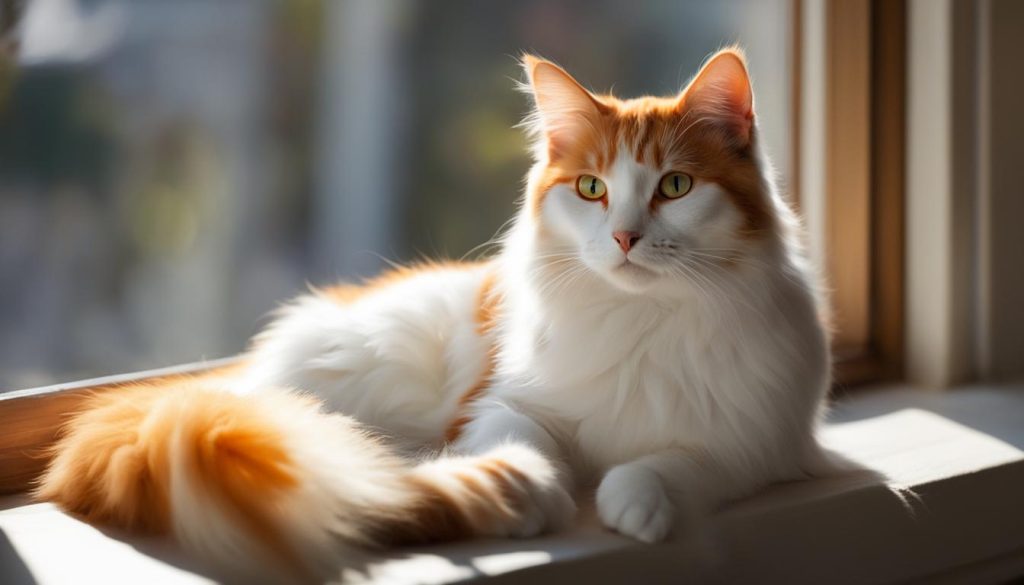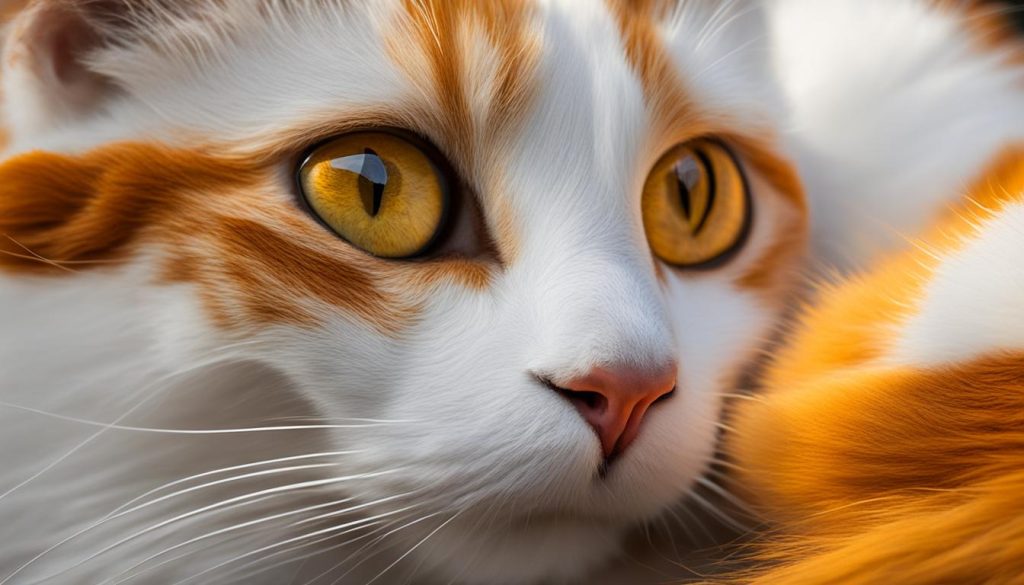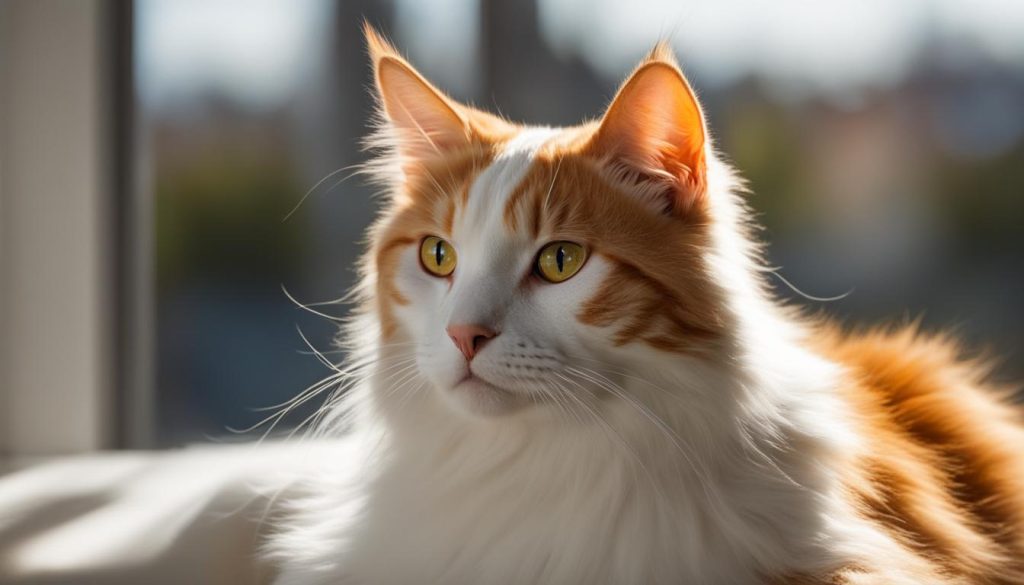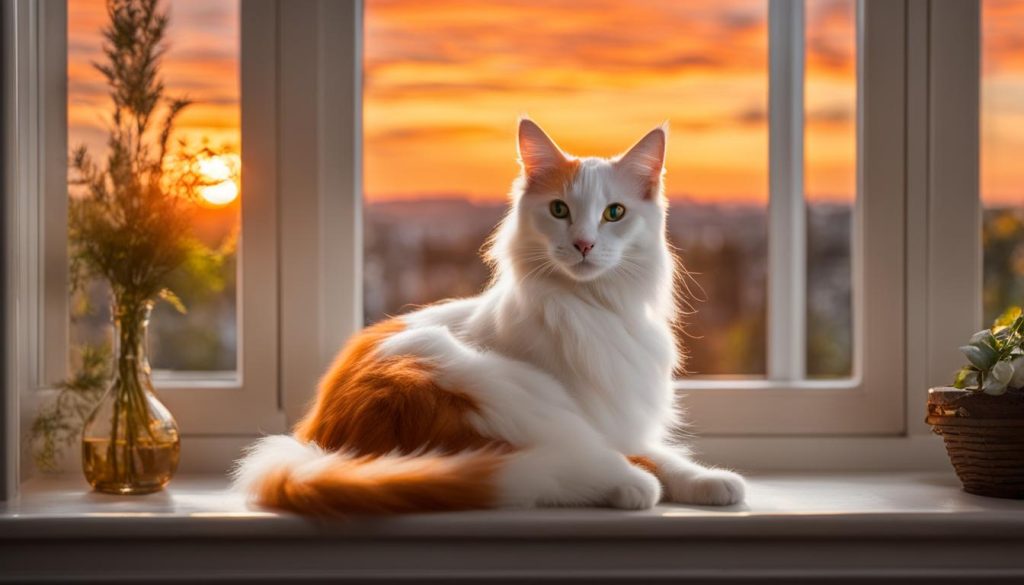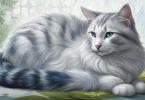Today, I invite you to embark on a delightful journey into the world of the magnificent Turkish Van cat breed. Specifically, we will unravel the allure of the enchanting orange Turkish Van cats. These captivating felines possess a unique coat pattern and a charm that is hard to resist!
As passionate cat breeders and caretakers, it is important to learn about different cat breeds, their characteristics, and their care needs. The Turkish Van cat is a treasure among pet cats, and its vibrant orange coat makes it truly stand out. Whether you are a seasoned cat lover or just starting your feline journey, the Turkish Van cat will surely capture your heart.
So, let’s dive in and discover what makes the orange Turkish Van cat so special. From their illustrious breed history to their captivating eye colors, we will explore it all. Join me on this exciting adventure!
Key Takeaways:
- The Turkish Van cat breed boasts a unique orange coat pattern that sets them apart from other cats.
- Originating from southeast Turkey, the breed has an interesting history that spans across different countries.
- Turkish Van cats have a sturdy yet graceful body structure and a soft, cashmere-like coat texture.
- Their eye colors can range from amber to blue, with some cats even having odd-eyed variations.
- While Turkish Van cats are rare, it’s important to note that cats with similar coat patterns can be found among domestic shorthair and longhair breeds.
Turkish Van Cats: Breed History
The Turkish Van Cats have a fascinating history that stretches back to ancient times. While the exact origins of the breed are uncertain, some theories suggest that they may have descended from cats brought by Crusaders from the Middle East. These cats eventually made their way to the region of Lake Van in southeast Turkey, where they developed their unique characteristics.
In the 1950s, Turkish Van Cats caught the attention of British breeders who were captivated by their striking appearance and charming personalities. In 1955, the breed was officially recognized in the United Kingdom and started gaining popularity among cat lovers.
It wasn’t until 1982 that Turkish Van Cats arrived in the United States. Their introduction to American shores opened up new opportunities for breeders and enthusiasts to appreciate and promote this rare and wonderful cat breed.
The Spread of Turkish Van Cats
The popularity of Turkish Van Cats has extended far beyond their native lands. These captivating felines have found homes in households around the world, thanks to their friendly nature, striking appearance, and unique coat pattern.
Today, Turkish Van Cats are cherished not only for their beauty but also for their playful and affectionate personalities. Whether you’re a fan of cat breeds or simply adore these furry companions, Turkish Van Cats are a breed with a fascinating history and a bright future.
Turkish Van Cats: Breed Description
The Turkish Van cat is a breed known for its unique appearance and charming personality. Let’s dive into the details of this fascinating breed and explore its distinctive features.
Coat Color and Pattern
The coat of a Turkish Van cat is predominantly chalk-white, with patches of color limited to the head and tail. These color patches can be various shades, including red, cream, or black. The contrast between the white body and the colored patches creates a striking and eye-catching look.
Coat Texture
The coat of a Turkish Van cat has a luxurious texture that is often compared to cashmere. It is soft, silky, and has a beautiful sheen. This unique coat texture adds to the overall elegance and charm of the breed.
Tail and Body Structure
The Turkish Van cat has a graceful and well-proportioned body structure. They are muscular and sturdy, yet agile and athletic. One of the distinctive features of the breed is its tail, which has a full and brush-like appearance. The tail adds to their overall elegance and is a beautiful accent to their appearance.
Eye Colors
Turkish Van cats have a wide range of eye colors, adding to their captivating look. The most common eye color for the breed is amber, giving them a warm and inviting gaze. They can also have stunning blue eyes, which create a striking contrast against their white coat. Additionally, Turkish Van cats can have odd-eyed, where one eye is blue and the other is amber. This unique combination of eye colors adds to their charm and intrigue.
| Coat Color | Coat Pattern | Coat Texture | Tail | Eye Colors |
|---|---|---|---|---|
| Chalk-white | Patches limited to head and tail | Soft and cashmere-like | Full and brush-like | Amber, blue, odd-eyed |
5 Fascinating Facts about Turkish Van Cats
If you’re a cat lover, you’ve probably heard of Turkish Van cats. These beautiful felines are known for their stunning orange coat and captivating personality. But did you know that there are some fascinating facts about Turkish Van cats that make them even more unique? Let’s explore five intriguing facts about these rare treasures.
- The Piebald Gene: Turkish Van cats owe their distinct coat pattern to the presence of the piebald gene. This gene gives them their white fur with patches of color, making them stand out from other cat breeds. It’s this gene that creates the iconic look of a Turkish Van cat, with its predominantly white body and colored head and tail.
- Swimming Cats: While not all Turkish Van cats enjoy swimming, many of them have a natural affinity for water. They are known to play and paddle in shallow water, making them quite unique among cat breeds. This behavior is thought to be a result of their ancestors’ exposure to bodies of water in the Van region of Turkey, where they originated.
- Different from Turkish Angora: Turkish Van cats are often mistaken for Turkish Angora cats due to their similar appearance. However, they are two distinct breeds with different characteristics. Turkish Van cats have a semi-longhaired coat, while Turkish Angora cats have a long, silky coat. Additionally, Turkish Van cats have a more substantial body structure and a unique coat pattern that sets them apart.
- The Van Pattern and Other Breeds: The Van pattern, characterized by a mostly white body with colored markings on the head and tail, is not exclusive to Turkish Van cats. This pattern can also be found in other cat breeds, such as the Turkish Angora and Japanese Bobtail. The presence of the Van pattern in these breeds is a testament to the fascinating genetics behind coat patterns in cats.
- A Rare Treasure: Turkish Van cats are considered a rare breed. Due to their unique appearance and captivating personality, they are highly sought after among cat lovers and breed enthusiasts. If you’re lucky enough to own a Turkish Van cat, you have a rare treasure in your home.
Turkish Van cats are truly remarkable creatures. From their distinct coat pattern to their love for water, they continue to captivate cat lovers around the world. These fascinating facts about Turkish Van cats only scratch the surface of what makes them so special. Whether you’re a fan of their unique appearance or their playful nature, Turkish Van cats are a breed that deserves recognition and admiration.
Is My Cat a Turkish Van?
If you’ve been captivated by the unique beauty of Turkish Van cats and suspect that your feline friend may have a resemblance to this extraordinary breed, you might be wondering if your cat is a Turkish Van. While Turkish Vans are a rare breed, it is possible for cats to have similar coat patterns without being purebred Turkish Vans.
Without proper registration from an ethical breeder, it’s challenging to determine if your cat is indeed a Turkish Van. Cats with comparable coat patterns can be found among domestic shorthair and longhair cats, and these lookalikes can still make wonderful companions.
To have a more definitive answer and ensure the accuracy of your cat’s breed identification, it’s best to consult with a veterinarian or a cat breed expert. They can assess various factors including physical characteristics, temperament, and lineage to provide a more informed conclusion.
Table: Key Differences between Turkish Van Cats and Lookalikes
| Criteria | Turkish Van Cats | Lookalikes (Domestic Shorthair/Longhair) |
|---|---|---|
| Coat Pattern | Distinct limited color patches on the tail and head | Possible similar coat patterns |
| Coat Texture | Soft and cashmere-like | Variety of textures |
| Body Structure | Sturdy yet graceful | Variety of body structures |
| Eye Color | Variety of colors including amber, blue, and odd-eyed | Variety of eye colors |
| Breed Registration | Registered with reputable breeders | No formal registration |
Please note that this table serves as a general guide and does not guarantee the identification of a Turkish Van breed.
Orange Eyes in Cats: A Unique Trait
When it comes to cat eye colors, orange eyes are a rare and captivating feature. While many cat breeds can have a variety of eye colors, including blue, green, or yellow, orange eyes are considered quite unique. Some cat breeds that can occasionally have orange eyes include the Devon Rex, Japanese Bobtail, American Wirehair, Maine Coon, Turkish Van, and Scottish Fold.
Orange eyes in cats are truly mesmerizing, adding an extra touch of charm to their already striking appearance. The intensity of the orange color can vary from a vibrant amber hue to a subtle copper tone, making each cat’s eyes truly one-of-a-kind.
It’s important to note that while orange eyes can be found in different cat breeds, eye color alone is not enough to determine a cat’s breed, especially if it is not a registered purebred. Cat eye color is determined by the amount and distribution of melanin in the iris, and it can vary within breeds. Therefore, if you come across a cat with orange eyes, it doesn’t necessarily mean it belongs to a specific breed. However, the presence of orange eyes is still a remarkable and cherished trait in feline companions.
As enthusiasts of feline beauty, we can appreciate the rarity and allure of orange eyes in cats. Whether your cat has orange eyes or not, their uniqueness and individuality are what make them special companions in our lives.
Decoding Cat’s Breed by Eye Color
When it comes to determining a cat’s breed based on eye color, things can get a bit tricky. While certain cat breeds may have a higher likelihood of having specific eye colors, it’s important to remember that eye color alone is not a definitive indicator of a cat’s breed. This is especially true when it comes to cats with orange eyes.
Domestic shorthair and longhair cats can occasionally have orange eyes, but they are not considered purebred Turkish Vans. The coat pattern and other physical characteristics, along with genetic factors, play a significant role in determining a cat’s breed. So, while eye color can be an interesting feature to observe, it is just one piece of the puzzle when it comes to decoding a cat’s breed.
To further complicate matters, eye color can vary within breeds due to genetic factors. This means that even cats of the same breed may have different eye colors. Therefore, it’s best not to rely solely on eye color when trying to determine a cat’s breed. Instead, it’s important to consider a combination of factors including coat pattern, physical traits, and genetic information.
“While eye color can be an interesting feature to observe, it is just one piece of the puzzle when it comes to decoding a cat’s breed.”
Decoding Cat’s Breed
Decoding a cat’s breed requires a comprehensive evaluation of various factors. Here are some key considerations:
- Coat Pattern: The coat pattern can provide valuable clues about a cat’s breed. Different breeds have distinct coat patterns, such as the Van pattern in Turkish Vans. Comparing the cat’s coat pattern to breed standards can help narrow down the possibilities.
- Physical Traits: Beyond eye color, examining other physical traits can also help in decoding a cat’s breed. These traits can include body structure, ear shape, and tail length, among others.
- Genetic Information: Genetic testing can provide more accurate insights into a cat’s breed. DNA tests can identify specific breed markers and confirm or rule out certain breeds.
By considering these factors in combination, it is possible to gain a better understanding of a cat’s breed. While eye color can be intriguing, it is important to remember that it is just one piece of the puzzle. So, if you’re curious about your cat’s breed, be sure to take a holistic approach when decoding their ancestry.
Table: Cat Breeds and Common Eye Colors
| Cat Breed | Common Eye Colors |
|---|---|
| Domestic Shorthair | Varies (including orange) |
| Domestic Longhair | Varies (including orange) |
| Turkish Van | Amber, Blue, Odd-eyed (Amber and Blue) |
Delving into Orange-Eyed Cat Breeds
Orange eyes in cats are a captivating and rare feature that can be found in several cat breeds. These breeds, including the Devon Rex, Japanese Bobtail, American Wirehair, Maine Coon, Turkish Van, and Scottish Fold, occasionally flaunt this unique eye color, adding to their overall charm and allure. While orange eyes are not exclusive to these breeds, they are more commonly seen in them.
Each of these cat breeds has its own distinct characteristics and personality traits. The Devon Rex, known for its curly coat, is a playful and mischievous companion. The Japanese Bobtail, with its short tail and expressive eyes, is highly sociable and intelligent. The American Wirehair, the result of a spontaneous mutation, has a distinctive wiry coat that requires minimal grooming.
The Maine Coon, one of the largest domestic cat breeds, is known for its friendly and affectionate nature. The Turkish Van, with its unique coat pattern and love for swimming, is an active and energetic breed. The Scottish Fold, recognized for its folded ears, is known for its sweet and gentle temperament. These cat breeds, with their orange eyes and individual characteristics, offer a diverse range of options for cat lovers looking for a feline companion.
| Cat Breed | Description | Personality |
|---|---|---|
| Devon Rex | Curly-coated breed | Playful and mischievous |
| Japanese Bobtail | Short tail and expressive eyes | Highly sociable and intelligent |
| American Wirehair | Distinctive wiry coat | Minimal grooming required |
| Maine Coon | One of the largest domestic cat breeds | Friendly and affectionate |
| Turkish Van | Unique coat pattern, love for swimming | Active and energetic |
| Scottish Fold | Folded ears | Sweet and gentle |
Notable Breeds
Among these breeds, the Turkish Van stands out with its striking orange eyes and distinctive coat pattern. The Turkish Van is known for its love of water and playful nature, making it a unique and entertaining companion. While these breeds may occasionally exhibit orange eyes, it’s important to note that eye color alone does not determine a cat’s breed. It’s best to consult a reputable breeder or look for breed-specific traits to ensure the authenticity of a cat’s breed.
Having orange-eyed cat breeds, such as the Devon Rex, Japanese Bobtail, American Wirehair, Maine Coon, Turkish Van, or Scottish Fold, can bring a touch of fascination and uniqueness to any cat lover’s life. These breeds offer a variety of personalities and characteristics that cater to different preferences and lifestyles. Whether you’re drawn to their orange eyes or their individual traits, these breeds are sure to charm and delight.
In summary, several cat breeds, including the Devon Rex, Japanese Bobtail, American Wirehair, Maine Coon, Turkish Van, and Scottish Fold, can occasionally possess orange eyes, adding to their overall appeal. Each breed has its own distinct characteristics and traits, making them unique companions for cat lovers. While orange eyes are not exclusive to these breeds, they are more commonly seen in them, making them even more captivating and special.
A Deeper Look into the Science of Cat Eye Color
The mesmerizing colors of a cat’s eyes have always been a subject of fascination. But have you ever wondered how these vibrant hues are determined? It all comes down to the science of cat eye color, which is influenced by factors such as melanin, iris pigmentation, and genetics.
Melanin, a pigment found in various parts of the body, plays a significant role in determining eye color. The amount and distribution of melanin in the iris, the colored part of the eye, give rise to different shades. Cats with a higher concentration of melanin tend to have darker eye colors, while those with less melanin exhibit lighter shades.
Genetics also play a crucial role in determining cat eye color. Different genes interact to produce specific pigmentation patterns, resulting in a wide range of eye colors. For example, the presence of a specific gene can give rise to orange eyes, which are considered rare and captivating.
In addition to orange, other rare eye colors in cats include copper-colored eyes and eyes with heterochromia iridium, where each iris has a different color. These unique eye colors add to the allure and individuality of certain cat breeds, making them even more intriguing to cat enthusiasts.
Table: Cat Eye Colors and Their Rarity
| Eye Color | Rarity |
|---|---|
| Orange | Rare |
| Copper | Rarer |
| Heterochromia Iridium | Rarest |
Understanding the science behind cat eye color adds a new layer of appreciation for these enchanting creatures. From the influence of melanin to the role of genetics, each aspect contributes to the diversity and beauty of cat eye colors. So, the next time you gaze into the eyes of a feline friend, take a moment to appreciate the fascinating science behind their captivating gaze.
The Most Common Eye Color in Cats
When it comes to eye colors in cats, yellow or amber eyes take the crown for being the most common. These warm and vibrant hues are seen in a wide range of cat breeds, exuding a sense of warmth and mystery. Following closely behind are hazel eyes, which possess a captivating blend of brown and green tones. These eye colors add depth and allure to a cat’s gaze.
Blue eyes, on the other hand, are more commonly observed in white cats. This striking contrast between their pale fur and deep blue eyes creates a captivating aesthetic. Blue eyes in cats result from a lack of melanin, allowing for the scattering of light in the collagen fibers of the iris. The mesmerizing effect of blue eyes is truly enchanting.
While yellow, amber, and blue eyes take the lead in terms of commonality, it’s important to note that every cat is unique, and eye color can vary within breeds. Some cats may even have heterochromia iridium, where each iris is a different color, adding an extra touch of intrigue to their appearance.
What Is The Rarest Eye Color For Cats?
When it comes to eye color, cats display a wide range of hues, from the common yellow and amber eyes to the mesmerizing blue eyes seen in certain breeds. But what about the rarest eye color for cats? While orange eyes are considered rare, the title of the rarest eye color goes to copper eyes. Cats with copper-colored eyes have a rich, deep shade that adds to their allure and uniqueness.
In addition to copper eyes, another rare eye phenomenon seen in cats is heterochromia iridium, where each iris is a different color. This condition results from variations in the distribution of melanocytes, the cells responsible for producing melanin. Cats with heterochromia iridium have one eye that may be copper-colored while the other eye may be blue or green, creating a striking and captivating appearance.
The genetics behind eye color in cats are intricate and fascinating. The amount and distribution of melanin in the iris play a crucial role in determining eye color. Melanin is responsible for the pigmentation of various body parts, including the eyes, and its levels and patterns result in different eye colors. The rarer the eye color, the more unique and captivating the cat’s appearance.
Table: Eye Colors in Cats and their Rarity
| Eye Color | Rarity |
|---|---|
| Yellow/Amber | Common |
| Hazel | Common |
| Blue | Rare (seen in white cats) |
| Orange | Rare |
| Copper | Rarest |
While orange and copper eyes are considered rare, it’s important to note that eye color alone is not a definitive indicator of a specific breed. Eye color can vary within breeds, and cats with a particular eye color may or may not belong to a specific breed. Regardless of rarity, all cats are unique in their own way, and their eye color adds to their individual charm and beauty.
Conclusion
In conclusion, Turkish Van cats are truly a rare and captivating breed. With their unique orange coat pattern and eye color, they stand out among other cat breeds. While some other cat breeds may occasionally have orange eyes, Turkish Vans are known for this distinct feature.
Their striking appearance is matched by their captivating personality, making them a favorite among cat lovers. Whether you own a Turkish Van or simply appreciate their uniqueness, these cats are a true treasure.
With their combination of alluring eye color and fascinating coat pattern, Turkish Van cats bring a touch of elegance and rarity to the world of cat breeds. Their individuality sets them apart and makes them a truly special addition to any cat lover’s home.
FAQ
What is the history of Turkish Van cats?
The exact origins of Turkish Van cats are uncertain, but some reports suggest they may have been brought to Europe by Crusaders. The breed arrived in the United Kingdom in 1955 and later made its way to the United States in 1982.
What are the characteristics of Turkish Van cats?
Turkish Van cats have a chalk-white body with color patches limited to the tail and head. Their coat texture is soft and cashmere-like, and their tail has a brush-like appearance. They have a sturdy yet graceful body structure and a variety of eye colors, including amber, blue, and odd-eyed.
What are some fascinating facts about Turkish Van cats?
Turkish Van cats have the piebald gene that gives them their white fur with patches of color. They are often associated with a myth about their love for swimming. They are distinct from Turkish Angora cats. The Van pattern has spread to other cat breeds. Turkish Van cats are also considered rare in the cat world.
How can I tell if my cat is a Turkish Van?
Without proper registration from an ethical breeder, a cat with a similar coat pattern may resemble a Turkish Van but is not a purebred. Cats with similar coat patterns can be found among domestic shorthair and longhair cats.
Can cats other than Turkish Vans have orange eyes?
Yes, several cat breeds, including the Devon Rex, Japanese Bobtail, American Wirehair, Maine Coon, Turkish Van, and Scottish Fold, can have orange eyes. However, it’s important to note that eye color alone is not enough to determine a cat’s breed if it is not a registered purebred.
How is cat eye color determined?
Cat eye color is determined by the amount and distribution of melanin in the iris. More melanin results in darker eye colors, while less melanin results in lighter eye colors. Blue eyes in cats are a result of the Tyndall effect, where light scatters in the collagen fibers of the iris.
What is the most common eye color in cats?
Yellow or amber eyes are the most common eye color in cats, followed by hazel. Blue eyes, which lack melanin, are commonly seen in white cats. Orange eyes, on the other hand, are considered rarer and can be quite striking.
What is the rarest eye color for cats?
The rarest eye color for cats is copper, which is the darkest and rarer shade. Cats with heterochromia iridium, where each iris is a different color, are also quite rare. The amount of melanin produced by melanocytes determines the eye color of cats.
